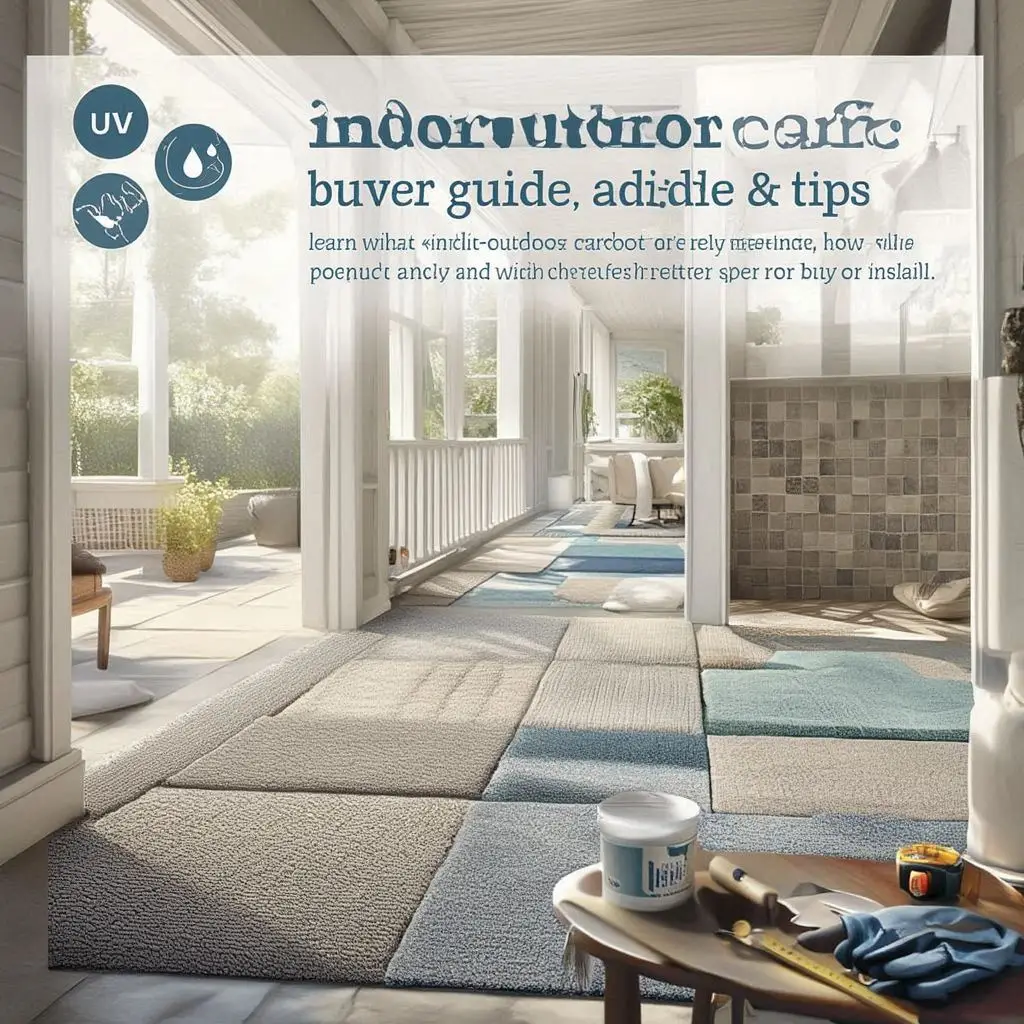
Indoor Outdoor Carpet: Buyer’s Guide, Adhesive & Tips
Upgrade patios, porches, and mudrooms with indoor outdoor carpet that resists UV, moisture, and heavy foot traffic. This expert guide covers materials, retailer comparisons, adhesives, color trends, tiles, FAQs, and pro tips for clean, durable installs.
INTRODUCTION
SEO snippet: Learn what “indoor outdoor carpet” really means, how it performs, and which specs matter before you buy or install.
Indoor outdoor carpet is a textile-based flooring designed to bridge the gap between exterior durability and interior comfort. Indoor-outdoor carpets are typically woven from polypropylene (olefin), polyester, or blends that are dyed at the fiber stage. This process creates UV-stable colors, resists mold and moisture, and provides a softer feel compared to bare decks or stone patios Because “outdoor” conditions vary (covered balcony vs. open dock), choosing the right backing, pile construction, and adhesive is essential.
From a textile standpoint (a core product category at Novin Trades), fiber quality, denier, yarn twist, UV stabilization, and backing chemistry determine longevity. Opt for solution-dyed yarns, where pigments are blended into the fiber during production, ensuring long-lasting color stability. Pair this with needle-punch or low-loop constructions for drainage, and marine-grade backings for moisture resistance.” For IAQ (indoor air quality) in semi-enclosed spaces, verify low-VOC adhesives and observe local standards.
LSI keywords: outdoor rug vs carpet, UV-resistant carpet, marine carpet, mold-resistant flooring, patio flooring textile, solution-dyed polypropylene, needle-punch carpet, carpet backing types, low-VOC flooring.
External links:
• <a href="https://carpet-rug.org/" target="_blank">Carpet and Rug Institute (CRI) – standards & resources</a>
• <a href="https: //www.epa.gov/ indoor-air-quality-iaq/volatile-organic-compounds-impact-indoor-air-quality" target="_blank">EPA – VOCs & indoor air quality</a>
• <a href="https://www.astm.org/" target="_blank" rel="nofollow">ASTM – materials & textile test methods</a>
INDOOR OUTDOOR CARPET
SEO snippet: Key specs for selecting the best indoor outdoor carpet: fiber, backing, weight, drainage, slip resistance, and UV stability.
Materials & construction:
- Fibers: Polypropylene/olefin is popular for UV and moisture resistance; polyester offers richer dyeing and soft hand; nylon has excellent resilience but needs UV stabilization outdoors.
- Solution-dyed yarns: Superior colorfastness vs. piece-dyed.
- Pile build: Needle-punched felt or tight low-loop (Berber) promotes drainage and resists snagging.
- Face weight & density: Heavier isn’t always better outdoors; prioritize drainage and quick dry.
- Backing: Marine-grade rubber or urethane for water resistance; PVC or gel foam for comfort in covered areas.
- Texture & slip: Ribbed and structured surfaces improve traction when wet.
Performance cues to compare: UV exposure rating, chlorinated-water tolerance (pool areas), mildew-resistant treatment, dimensional stability (won’t ripple), and thermal comfort (doesn’t overheat in sun).
Where it shines: Covered patios, screened porches, sunrooms, basements with moisture control, garages, boats, tiny homes, garden offices, and high-traffic entryways.
Installation at a glance: Float with perimeter tape for temporary setups; fully adhere with moisture-tolerant adhesive for edges/ramps; use seam sealer on cut edges to prevent fray.
LSI keywords: outdoor patio carpet, balcony carpet, waterproof carpet, anti-slip outdoor flooring, UV-stable textile, ribbed outdoor carpet, marine-grade backing, mildew-resistant carpet.
External links:
• <a href="https://carpet-rug.org/resources/installation/" target="_blank">CRI – carpet installation best practices</a>
• <a href="https://www.cpsc.gov/Safety-Education/Safety-Guides" target="_blank">U.S. CPSC – home safety guidance</a>
• <a href="https://www.iso.org/committee/48550.html" target="_blank" rel="nofollow">ISO/TC 38 – Textiles standards overview</a>
INDOOR OUTDOOR CARPET HOME DEPOT
SEO snippet: How to use big-box filters and spec sheets to compare indoor outdoor carpets—without overpaying or missing key performance features.
Home-improvement marketplaces list hundreds of products. Treat them as data sources, not just stores. Focus on specs, not marketing names:
- Filter by material first: Polypropylene/olefin or solution-dyed polyester for UV & moisture.
- Check backing & use location: “Marine/outdoor,” “basement,” or “garage” labels indicate tolerance to moisture and abrasion.
- Scrutinize warranty language: Look for UV fade and stain guarantees and what “outdoor” covers (covered vs. uncovered).
- Rolls vs. tiles: Rolls are economical for large patios; tiles simplify DIY and repairs.
- Sampling: Order swatches to test color in sun/shade; rub with a damp white cloth to check color transfer; hose test for drainage and dry time.
Pro tip from a textile lens (Novin Trades): Compare GSM (grams per square meter) when available. For outdoor use, a mid-range GSM with an open structure can outlast overly plush options that trap water.
LSI keywords: best indoor outdoor carpet, UV fade warranty, outdoor carpet roll vs tile, patio carpet price per square foot, compare outdoor carpet specs.
External links:
• <a href="https://www.ftc.gov/business-guidance/resources/green-guides" target="_blank">FTC – Green Guides (marketing claims like “weather-resistant”)</a>
• <a href="https://www.energy.gov/energysaver/energy-efficient-home-design/insulation" target="_blank">U.S. DOE – thermal comfort & surfaces in sunrooms</a>
INDOOR OUTDOOR CARPET LOWE'S
SEO snippet: Lowe’s-style spec sheets can help you benchmark fiber, backing, thickness, and warranty—then source smarter.
Use the same evaluation framework across retailers so you’re comparing apples to apples:
- Thickness vs. drainage: A modest thickness with ribbed texture may outperform plush piles in open rain.
- Edge finishing: Look for bound edges on runners; plan to bind or heat-seal cut edges on rolls.
- Traffic rating: Prioritize “heavy residential” or “light commercial” for entryways/garages.
- Colorfastness: Seek language such as “solution-dyed,” “UV stabilized,” or “outdoor grade.”
- Maintenance: Prefer fibers that clean with hose, mild detergent, and soft brush; avoid harsh solvents that can degrade backing.
Sourcing strategy: Shortlist 3–5 SKUs across big-box stores, then compare to Novin Trades’ textile specifications (fiber, GSM, UV rating). Choose by environment: covered porch ≠ pool surround.
LSI keywords: compare outdoor carpet, heavy-traffic outdoor flooring, colorfast outdoor carpet, maintenance for patio carpet.
External links:
• <a href="https://www.epa.gov/saferchoice" target="_blank">EPA Safer Choice – cleaning products database</a>
• <a href="https://www.nist.gov/pml/weights-and-measures" target="_blank">NIST – weights & measures (GSM, thickness references)</a>
INDOOR OUTDOOR CARPET ADHESIVE
SEO snippet: Choose low-VOC, moisture-tolerant adhesives and the right trowel notch to prevent bubbles, ripples, and early failure.
Adhesive types:
- Pressure-sensitive acrylics: Common for modular tiles; allow easier lift/replace.
- Outdoor/marine adhesives (solvent-free where possible): Formulated for humidity, temperature swings, and occasional standing water.
- Double-sided tapes: Good for temporary or perimeter holds on covered patios; look for outdoor-rated tapes.
Selection factors: Substrate (concrete, plywood, old tile), moisture emission (do an MVER/RH test if indoors), temperature range, UV exposure, and slope/drainage. Use manufacturer-specified trowel notch and open time; roll with a 50–75 lb roller where required.
VOC & safety: For semi-enclosed spaces, choose low-VOC adhesives and ventilate during cure. Follow PPE guidance and read SDS.
Detailing that extends life: Flash-cove edges near splash zones, seal seams with carpet seam sealer, and add transition strips at door thresholds.
LSI keywords: outdoor carpet glue, marine carpet adhesive, low-VOC flooring adhesive, pressure-sensitive adhesive, trowel notch size, moisture vapor emission.
External links:
• <a href="https://www.aqmd.gov/home/rules-compliance/rules/scaqmd-rule-1168" target="_blank">South Coast AQMD Rule 1168 – VOC limits for adhesives & sealants</a>
• <a href="https://www.osha.gov/chemicalhazards" target="_blank">OSHA – chemical hazards & PPE basics</a>
• <a href="https://www.epa.gov/indoor-air-quality-iaq" target="_blank">EPA – Indoor Air Quality portal</a>
BLACK INDOOR OUTDOOR CARPET
SEO snippet: Black outdoor carpet delivers sleek, modern lines—but manage heat build-up, fading, and debris visibility.
Design & performance: Black reads minimal and hides many stains, but it absorbs more solar heat. In full sun, prefer ribbed or textured surfaces that allow airflow underfoot and choose solution-dyed fibers with UV stabilizers. In shaded or covered areas, black creates high contrast with light facades and furniture.
Where black excels: Modern patios, commercial entries, retail displays, shaded decks, and monochrome landscaping schemes. Pair with lighter trims or metal accents to prevent “visual heaviness.”
Care tips: Sweep frequently to remove dust/pollen that show on dark fibers. Hose gently and brush with mild detergent. Avoid chlorine splash where possible; if near pools, confirm “chlorine-tolerant” in specs.
LSI keywords: dark outdoor carpet, UV fade black carpet, heat management flooring, modern patio carpet, ribbed black runner.
External links:
• <a href="https://www.noaa.gov/education/resource-collections/weather-atmosphere/uv-index" target="_blank">NOAA – UV Index basics</a>
• <a href="https://www.energy.gov/energysaver/energy-efficient-home-design/cool-roofs" target="_blank">U.S. DOE – solar heat considerations (surface color)</a>
GREEN INDOOR OUTDOOR CARPET
SEO snippet: Green outdoor carpet brings garden synergy; pick the right shade and fiber to avoid turf-look fatigue and premature fading.
Style notes: From muted sage to deep forest, green integrates with landscaping without imitating artificial turf. Choose solution-dyed greens to resist bleaching; medium tones hide dust better than very dark or very light hues.
Use cases: Garden walkways, gazebos, pergolas, lakeside docks, and rustic cafés. Pair with wood or stone for biophilic design.
Sustainability angle: Prefer backing systems with recycled content where available and adhesives that meet strict VOC thresholds for semi-enclosed spaces.
Maintenance: Periodic rinse, gentle neutral cleaner, and sun rotation for movable rugs/runners reduce shade lines.
LSI keywords: green patio carpet, garden carpet flooring, UV-resistant green carpet, eco outdoor carpet, recycled backing.
External links:
• <a href="https://www.epa.gov/smm/sustainable-management-materials" target="_blank">EPA – Sustainable Materials Management</a>
• <a href="https://www.iso.org/standard/61569.html" target="_blank" rel="nofollow">ISO 105-B02 – color fastness to artificial light (overview)</a>
INDOOR OUTDOOR CARPET TILES
SEO snippet: Carpet tiles are the DIY winner—modular, repairable, and ideal for irregular patios, balconies, and workshops.
Why tiles:
- Modularity: Replace only damaged squares after storms or spills.
- Easy installs: Pressure-sensitive adhesive or tabs; minimal tools.
- Design freedom: Checkerboards, borders, pathways, or zoning (e.g., dining vs. play).
- Drainage options: Some tiles include raised nubs or permeable backings to shed water.
Layout & install tips: Dry-fit first, snap chalk lines, start from center or a long reference edge, stagger seams for better visual flow, and leave expansion gaps where manufacturer specifies. Roll lightly to secure. On balconies, confirm that drainage scuppers remain unobstructed.
Where tiles shine: Balconies with slope, rooftop terraces, rental spaces (easy removal), and utility rooms.
LSI keywords: outdoor carpet tiles, peel-and-stick carpet, modular patio flooring, balcony carpet squares, DIY outdoor flooring.
External links:
• <a href="https://www.ready.gov/floods" target="_blank">Ready.gov – flood & storm preparedness (outdoor surfaces)</a>
• <a href="https://www.cdc.gov/mold/faqs.htm" target="_blank">CDC – mold prevention in damp areas</a>
FAQs (EXPANDED)
SEO snippet: Quick answers to common indoor outdoor carpet questions—materials, durability, adhesives, cleaning, and safety.
Q1. Is indoor outdoor carpet truly waterproof?
No textile carpet is fully waterproof. Quality products are water-resistant and fast-drying; pair with the right backing and drainage-friendly installation.
Q2. Which fiber lasts longest in the sun?
Solution-dyed polypropylene/olefin typically leads for UV stability; solution-dyed polyester can also perform well. Always check the UV fade warranty.
Q3. Can I install over existing concrete outside?
Yes, if the slab is sound, clean, and sloped for runoff. Use outdoor-rated adhesive/tape and follow manufacturer open time. Avoid trapping water under the carpet.
Q4. What adhesive should I use near pools?
A marine/outdoor, low-VOC adhesive rated for splash zones. Verify compatibility with chlorine and the carpet backing.
Q5. How do I prevent mildew?
Choose mildew-resistant fibers/backings, ensure ventilation and drainage, clean periodically, and avoid organic debris buildup under mats.
Q6. Are carpet tiles as durable as rolls outdoors?
They can be—especially raised or permeable-back tiles. Tiles are easier to service and replace, which effectively extends service life.
Q7. Does color affect temperature and fading?
Yes. Darker colors (e.g., black) get hotter and may show UV changes differently than lighter shades. Solution-dyed yarns mitigate fading.
Q8. How does Novin Trades fit in?
As a textile supplier, Novin Trades evaluates fiber grade, GSM, UV stabilization packages, and backing chemistry, helping you align carpet selection with real-world exposure and maintenance goals.
LSI keywords: outdoor carpet maintenance, UV fade warranty, marine adhesive, drainage installation, balcony flooring FAQ, textile supplier.
External links:
• <a href="https://carpet-rug.org/testing/colorfastness/" target="_blank">CRI – colorfastness & performance</a>
• <a href="https://www.epa.gov/indoor-air-quality-iaq/cleaning-and-choosing-products-healthy-cleaning" target="_blank">EPA – cleaning products & IAQ</a>
CONCLUSION
SEO snippet: Match fiber, backing, and adhesive to your environment—then install for drainage and low VOCs to maximize life and comfort.
Indoor outdoor carpet succeeds when you treat it like the technical textile it is. Start with the environment (covered vs. exposed), select solution-dyed fibers and drainage-friendly constructions, and choose low-VOC, moisture-tolerant adhesives. For dark aesthetics, manage heat; for modularity, choose tiles. Use retailer listings for specification benchmarking, then align with Novin Trades’ textile parameters (GSM, UV package, backing). With smart selection and installation, you’ll get soft underfoot comfort with outdoor-grade durability.
LSI keywords: patio carpet guide, outdoor carpet installation, low-VOC adhesive, solution-dyed polypropylene, marine carpet tiles, UV-resistant textile flooring.
External links:
• <a href="https://www.cdc.gov/healthyhomes/bytopic/chemicals.html" target="_blank">CDC – chemicals & home health</a>
• <a href="https://www.epa.gov/saferchoice" target="_blank">EPA – Safer Choice (cleaners)</a>
• <a href="https://carpet-rug.org/" target="_blank">CRI – industry resources</a>

